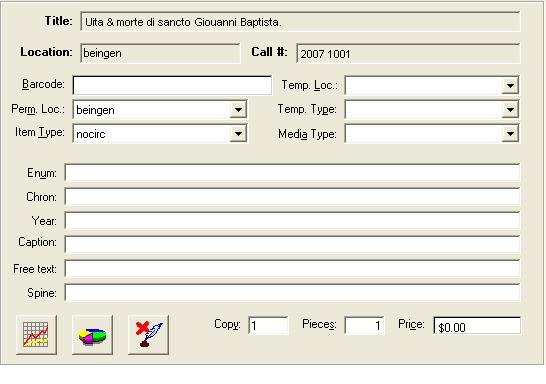Barcodes
Introduction
Barcodes are used to assign unique identifiers to library holdings. Because a barcode is assigned to a discrete physical item, barcodes can be used to track the location of separately-circulating components, such as a volume within a multi-part monograph. Most information in an item record is derived automatically from the associated bibliographic and holdings records. The only information entered manually is the scanned barcode, and in some cases keyed descriptive informations. It may be necessary to change preferences in the cataloging module for item records to reflect Beinecke practice.
For items records for separately published works bound together see: Bound With Volumes.
For item records for multiparts and serials see: Barcodes for Serials and Multi-part Monographs.
General procedures
The Beinecke will use the following item record fields:
Title, Location, and Call #
Derived from the MFHD
Barcode
Number from barcode label
Scanned or keyed in
Perm Loc
Determines location display in Orbis
Derived from MFHD for new records
Item Type
Determines type of circulation
Derived from code set in cataloging module options/preferences/item defaults/item type (set to nocirc)
Enum and chron
Can be used for descriptive information, such as volume or serial numbering (Enum), serial date (Chron), or to describe contents of item (e.g., A-Az or suppl. (Chron))
Enter manually, by keying text
Copy
Indicates the copy number (default set to 1 in Voyager preferences)
Change to 2 for copy 2, 3 for copy 3, etc.
Pieces
Indicates number of physical pieces associated with a barcode
Default is 1
Do not change
After the MFHD has been saved, click on New Items to create the item record.

Scan into the barcode field the barcode number from the label on the BLIPS, Gaylord or box. Type information into the Enum and Chron fields. Save the item record. Repeat if needed for additional volumes, etc., on the same MFHD.
For restricted material, see Restriction on access for procedures on applying statistical catagories to item records.
Accompanying material
If the accompanying material is to be housed with the main object (e.g., a map or CD in the pocket of a book, a prospectus housed in a Gaylord with the book it describes), update the number of pieces as appropriate.
If the accompanying material is housed separately and treated as a supplement in the MFHD, do not treat it as an additional piece in the item record for the main unit. Instead, create a second item record for the accompanying material, and enter suppl. in the Chron field of that item record.
| 852 | 8 | 0 | ‡a beingen ‡h 2005 ‡i 799 +suppl. |
For more information on material accompanying an item see Accompanying material.